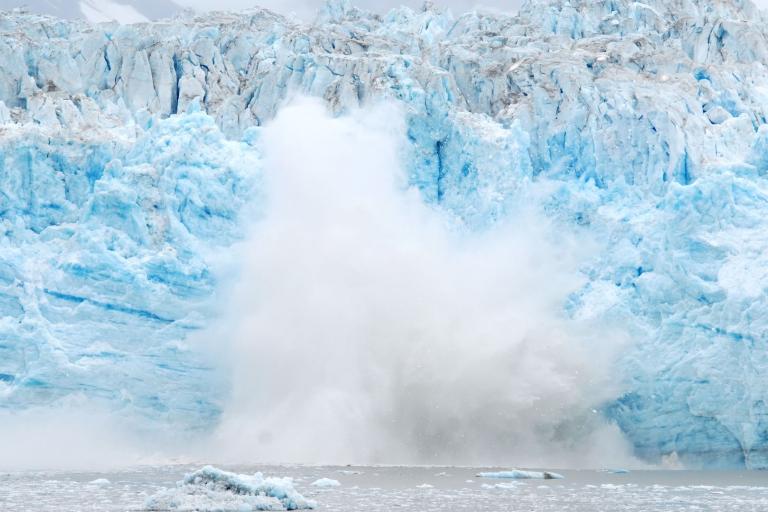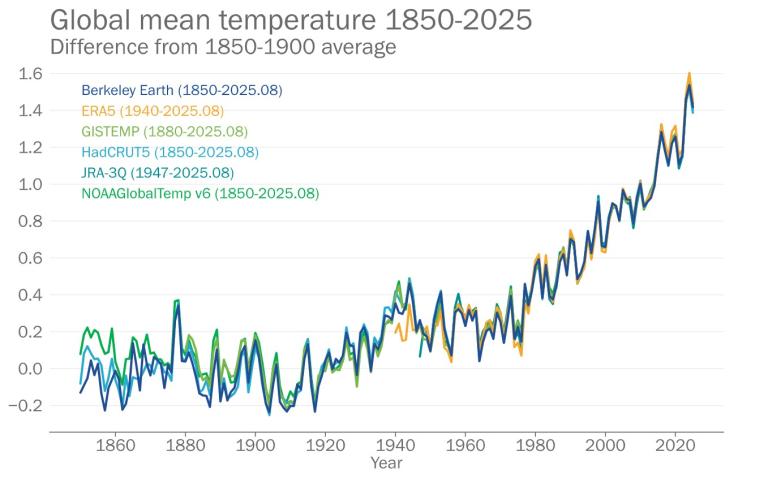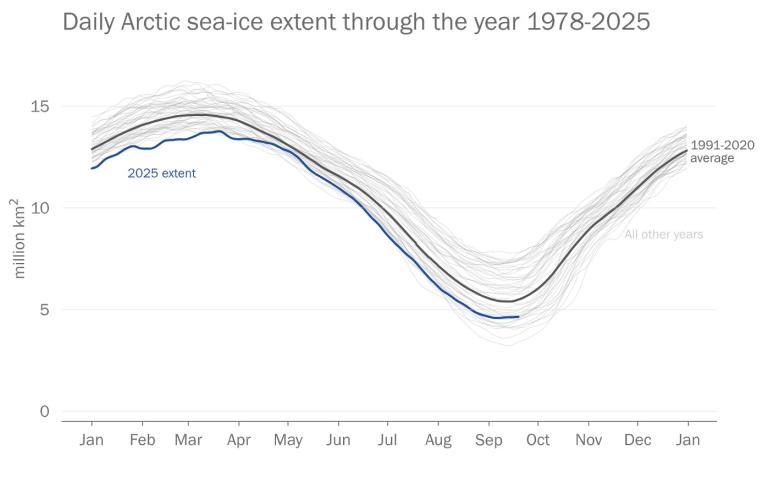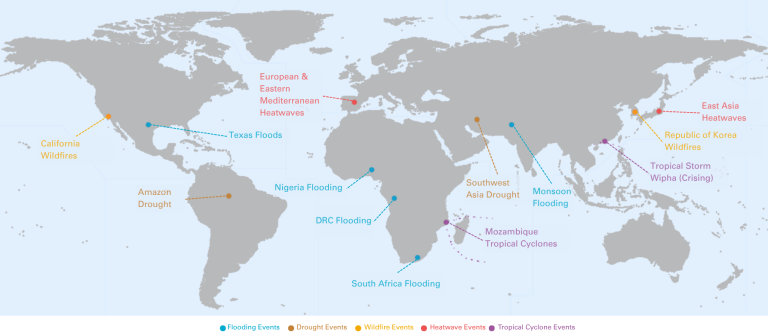2025 set to be second or third warmest year on record, continuing exceptionally high warming trend
The alarming streak of exceptional temperatures continued in 2025, which is set to be either the second or third warmest year on record, according to the State of the Global Climate Update from the World Meteorological Organization (WMO).
- Record greenhouse gas concentrations drive record heat
- Sea ice and glaciers continue to retreat
- Extreme weather causes massive social and economic disruption
- Early warning services advance to save lives
- Climate services support resilience
- WMO report released to inform COP30

The past 11 years, 2015 to 2025, will individually have been the eleven warmest years in the 176-year observational record, with the past three years being the three warmest years on record. The mean near-surface temperature in January-August 2025 was 1.42 °C ± 0.12 °C above the pre-industrial average, said the WMO report.
Concentrations of heat-trapping greenhouse gases and ocean heat content, which both reached record levels in 2024, continued to rise in 2025. Arctic sea ice extent after the winter freeze was the lowest on record, and Antarctic sea ice extent tracked well below average throughout the year. The long-term sea level rise trend continued despite a small and temporary blip due to naturally occurring factors, said the report.
Weather and climate-related extreme events to August 2025 – ranging from devastating rainfall and flooding to brutal heat and wildfires - had cascading impacts on lives, livelihoods and food systems. This contributed to displacement across multiple regions, undermining sustainable development and economic progress.
"This unprecedented streak of high temperatures, combined with last year's record increase in greenhouse gas levels, makes it clear that it will be virtually impossible to limit global warming to 1.5 °C in the next few years without temporarily overshooting this target. But the science is equally clear that it’s still entirely possible and essential to bring temperatures back down to 1.5 °C by the end of the century.” said WMO Secretary-General Celeste Saulo.
“Each year above 1.5 degrees will hammer economies, deepen inequalities and inflict irreversible damage. We must act now, at great speed and scale, to make the overshoot as small, as short, and as safe as possible – and bring temperatures back below 1.5 °C before the end of the century,” said UN Secretary-General António Guterres, who cited the WMO report in his statement to the Belém Climate Summit.
WMO released the State of the Global Climate Update 2025 for the Summit at the UN Climate Change Conference, COP30, in Belém, Brazil. It is a science-based reference to anchor COP negotiations in authoritative evidence. It highlights key climate indicators and their relevance to support policymaking and is a bridge to more detailed but less frequent scientific reports.
The report also provides a snapshot of how the WMO community is supporting decision-makers with weather and climate intelligence.
Since 2015, the number of countries reporting multi-hazard early warning systems (MHEWSs) has more than doubled – from 56 to 119 in 2024. However, 40% of countries still lack MHEWSs, and urgent action is needed to close these remaining gaps.
National Meteorological and Hydrological Services (NMHSs) have a growing role in climate action plans which increasingly recognize the importance of climate services such as seasonal outlooks in key sectors like agriculture, water, health and energy. Nearly two thirds of NMHSs now provide some form of climate services – varying from essential to advanced level – compared to approximately 35% just five years ago.
As climate-related drivers shape renewable energy supply and demand, it is essential to anticipate these influences to build reliable and flexible clean energy systems.
Highlights
Temperatures
Warming El Niño conditions which boosted global temperatures during 2023 and 2024 – gave way to neutral/La Niña conditions in 2025. The global mean near-surface temperature from January to August 2025 was therefore lower than 2024 – at 1.42 °C ± 0.12 °C above the pre-industrial average, compared to about 1.55 °C ± 0.13 °C for the year 2024.
The 26-month period from June 2023 to August 2025 saw an extended streak of monthly record-breaking temperatures (apart from February 2025).
The high global temperatures in the past three years relative to the preceding two years are related to the transition from a prolonged La Niña that lasted from 2020 to early 2023, but reductions in aerosols and other factors likely also played a role in the warming.

Ocean heat content
Ocean heat content continued to rise in 2025, according to preliminary data, above the record 2024 values. Ocean warming rates show a particularly strong increase over the past two decades, in an indication of how rapidly the Earth system is trapping surplus energy in the form of heat. Over 90% of that energy goes into warming the ocean.
Ocean warming has far-reaching consequences, including the degradation of marine ecosystems, loss of biodiversity, and a weakening of the ocean’s role as a carbon sink. It intensifies tropical and subtropical storms, accelerates sea-ice loss in the polar regions, and – together with melting land ice – drives sea-level rise. This warming is projected to continue, representing a change that is potentially irreversible on centennial to millennial timescales.
Sea level rise
The long-term rate of sea-level rise has increased since the start of the satellite record, nearly doubling from 2.1 millimeters per year between 1993 and 2002 to 4.1 mm/year between 2016 and 2025. This reflects the combined influence of ocean warming and thermal expansion, together with the melting of glaciers and ice sheets.
The year 2024 set a new observed record for annual global mean sea level. Preliminary 2025 data show it dropped slightly since the start of 2025 – but this is likely temporary behaviour due to La Niña and other factors.
Sea ice
Arctic sea-ice extent reached its annual maximum of 13.8 million km2 in March, the lowest maximum extent in the satellite record. Arctic sea-ice extent reached its annual minimum of 4.6 million km2 around 6 September 2025 and was below the long-term average.
Antarctic sea-ice extent was the third lowest on record – both for the annual minimum (2.1 million km2) in February 2025 and annual maximum (17.9 million km2) in September 2025.

Glaciers
The hydrological year 2023/2024 was the third consecutive year that all monitored glaciated regions around the world recorded net mass loss. A set of reference glaciers monitored by the World Glacier Monitoring Service indicate a global annual mass balance of −1.3 m of water equivalent, or 450 gigatonnes. This is equivalent to 1.2 mm of global mean sea-level rise and nominally the largest loss of ice on record back to 1950.
Greenhouse Gases
Concentrations of the three key greenhouse gases in the atmosphere – carbon dioxide, methane and nitrous oxide – reached record-high observed levels in 2024, the most recent year for which there are global consolidated figures. Measurements to date from individual locations suggest that they will be even higher in 2025.
The atmospheric concentration of CO2 has increased from around 278 parts per million (ppm) in 1750 to 423.9 ppm in 2024, an increase of 53%. The increase in concentration from 2023 to 2024 was 3.5 ppm, a record increase in the recent observational history.
Extreme events
Throughout 2025, extreme events caused massive economic and social upheaval and loss of life.
These included flooding in many countries in Africa and Asia, as well as wildfires in Europe and North America, extreme heat throughout the world, and deadly tropical cyclones.

Renewable Energy
As global renewable energy capacity expands, integrating climate data and science is essential across the sector’s value chain – from generation to transmission, distribution and dispatch. Climate-informed energy indicators make it possible to estimate impacts at every stage of this chain.
Globally, the record heat of 2024 drove energy demand to 4% above the 1991–2020 baseline. This anomaly far exceeded demand in previous years and varied significantly across regions, with demand in Central and Southern Africa nearly 30% above average.
These findings reinforce the need for climate-informed energy planning and operations. As renewable capacity expands globally, accounting for the influence of large-scale climate patterns is essential to build energy systems that are resilient and flexible in a changing climate.
Climate services
Climate insights like seasonal outlooks and heat-health information are emerging as indispensable components in the overwhelming majority of updated Nationally Determined Contributions, translating global climate commitments into real progress on the ground.
Nearly two thirds of NMHSs now provide essential to advanced level for climate services, notable progress compared to five years ago when it was approximately 35%. This trajectory is expected to continue, with essential to advanced-level service provision expected to exceed 90% by 2027 – dependent on sustained support from the global community.
Early Warning Systems
Effective multi-hazard early warning systems (MHEWSs) are more crucial than ever. Significant advances have been made toward the United Nations Secretary-General’s Early Warnings for All (EW4All) initiative, which aims for universal coverage by 2027.
Since 2015, the number of countries reporting MHEWSs has more than doubled – from 56 to 119 in 2024 – yet 40% of countries still lack MHEWSs. Progress is particularly notable among least developed countries (LDCs) and small island developing States (SIDSs), where reported coverage increased by about 5% in the past year alone.
Notes to Editors
The WMO State of the Global Climate Update 2025 is released for COP30. The final State of the Global Climate report for the year 2025 as a whole will be released in March 2026.
The temperature figures presented here are until August 2025 and are based on six international datasets. The Update is based on contributions from WMO Members, partners and experts.
The World Meteorological Organization (WMO) is a specialized agency of the United Nations responsible for promoting international cooperation in atmospheric science and meteorology.
WMO monitors weather, climate, and water resources and provides support to its Members in forecasting and disaster mitigation. The organization is committed to advancing scientific knowledge and improving public safety and well-being through its work.
For further information, please contact:
- Clare Nullis WMO media officer cnullis@wmo.int +41 79 709 13 97
- WMO Strategic Communication Office Media Contact media@wmo.int

